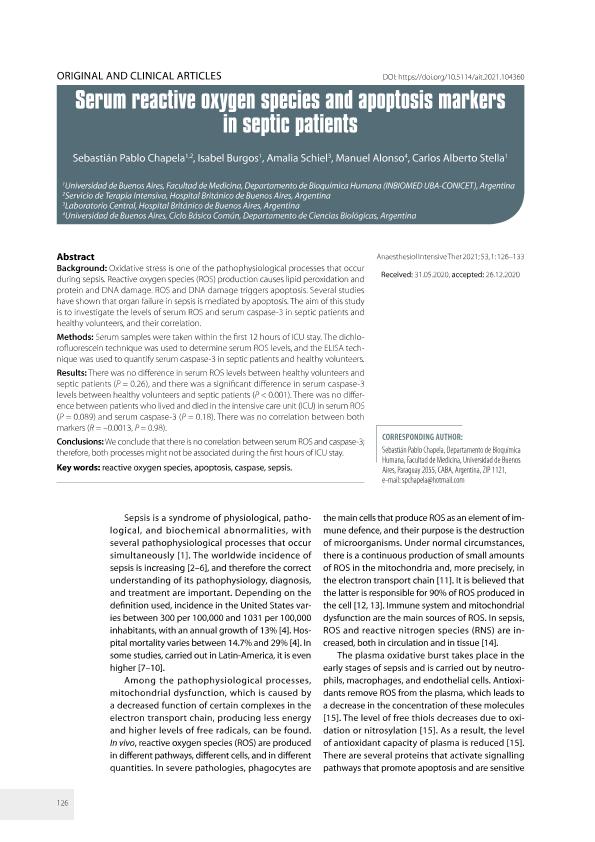Artículo
Serum reactive oxygen species and apoptosis markers in septic patients
Chapela, Sebastián Pablo; Burgos, Hilda Isabel ; Schiel, Amalia; Alonso, Manuel; Stella, Carlos Alberto
; Schiel, Amalia; Alonso, Manuel; Stella, Carlos Alberto
 ; Schiel, Amalia; Alonso, Manuel; Stella, Carlos Alberto
; Schiel, Amalia; Alonso, Manuel; Stella, Carlos Alberto
Fecha de publicación:
12/2020
Editorial:
Termedia Publishing House Ltd
Revista:
Anaesthesiology Intensive Therapy
ISSN:
1642-5758
e-ISSN:
1731-2531
Idioma:
Inglés
Tipo de recurso:
Artículo publicado
Clasificación temática:
Resumen
Background: Oxidative stress is one of the pathophysiological processes that occur during sepsis. Reactive oxygen species (ROS) production causes lipid peroxidation and protein and DNA damage. ROS and DNA damage triggers apoptosis. Several studies have shown that organ failure in sepsis is mediated by apoptosis. The aim of this study is to investigate the levels of serum ROS and serum caspase-3 in septic patients and healthy volunteers, and their correlation. Methods: Serum samples were taken within the first 12 hours of ICU stay. The dichlorofluorescein technique was used to determine serum ROS levels, and the ELISA technique was used to quantify serum caspase-3 in septic patients and healthy volunteers. Results: There was no difference in serum ROS levels between healthy volunteers and septic patients (P = 0.26), and there was a significant difference in serum caspase-3 levels between healthy volunteers and septic patients (P < 0.001). There was no difference between patients who lived and died in the intensive care unit (ICU) in serum ROS (P = 0.089) and serum caspase-3 (P = 0.18). There was no correlation between both markers (R =-0.0013, P = 0.98). Conclusions: We conclude that there is no correlation between serum ROS and caspase-3; therefore, both processes might not be associated during the first hours of ICU stay.
Palabras clave:
APOPTOSIS
,
CASPASE
,
REACTIVE OXYGEN SPECIES
,
SEPSIS
Archivos asociados
Licencia
Identificadores
Colecciones
Articulos(INBIOMED)
Articulos de INSTITUTO DE INVESTIGACIONES BIOMEDICAS
Articulos de INSTITUTO DE INVESTIGACIONES BIOMEDICAS
Citación
Chapela, Sebastián Pablo; Burgos, Hilda Isabel; Schiel, Amalia; Alonso, Manuel; Stella, Carlos Alberto; Serum reactive oxygen species and apoptosis markers in septic patients; Termedia Publishing House Ltd; Anaesthesiology Intensive Therapy; 53; 2; 12-2020; 126-133
Compartir
Altmétricas



